After hemming and hawing for a bit, I recently took the plunge and upgraded from my old Garmin Forerunner 245 to a Garmin Fenix 7S Pro Solar. You can read about my first impressions of the watch here.
One feature I was curious about – and not particularly sold on – was Garmin Fenix 7 solar charging capabilities. It used to be optional on the previous generation of Fenix watches, and I probably wouldn’t have splurged for the power glass if I had the option. But with the Pro generation, it comes default so there’s no choice.
Now that I’ve had the watch for a couple of weeks, I wanted to dig into the data to see – just how useful is Garmin’s solar charging on the Fenix 7S Pro (and other similar watches)?
More specifically – how many lux hours does it take to charge a Garmin Fenix 7 and how many lux hours can you expect to get under normal conditions?
Garmin Fenix 7S Pro Battery Life Specs
First, let’s look at the technical specs that Garmin provides for the Fenix 7S Pro.
It lists expected battery life under a variety of different circumstances. Depending on which mode you’re using, the battery will drain more or less quickly.
For example, in the default smartwatch mode – when you’re not tracking an activity – the expected battery life is 11 days without solar charging and 14 days with solar charging. That’s a 27% increase. Not bad.
If you’re tracking an activity, the GPS uses significantly more battery. The actual GPS mode matters as well, with multi-band GPS using the most battery. If you’re using all satellites and multi-band GPS, you can expect around 15 hours of battery life without solar charging and 16 hours of battery life with solar charging. That’s about a 7% increase – not so good.
On the other extreme, you can conserve battery power with expedition mode or battery saver mode. In this situation, the effect of solar charging is amplified. For example, in battery saver mode you can expect about 38 days of battery life without solar charging and a whopping 87 days of battery life with solar charging.
Of course, I don’t know why you’d purchase a Garmin watch if you’re just going to leave it in battery saver mode for 87 straight days.
Overall, the point is that the more you use your watch to track activities and/or play music (which also places a huge drain on the battery), the less impact you’ll see from solar charging.
Expected Increase In Battery Life From Solar Charging
I put together a spreadsheet that calculates the increase in battery life you can expect to see in different circumstances. This is based on Garmin’s published specs. Note that battery life is always expressed in days on this chart, so 0.63 days is 15 hours. You’ll see that the Fenix 7 Pro and Fenix 7X Pro reap more benefits from solar charging. This is because they have larger batteries to begin with.

The Fine Print – How Many Lux Hours Do You Need?
Before you get too excited, though, it’s worth reading the fine print behind these battery life specs.
According to Garmin, these battery life specs are based on the assumption that you wear your watch all day, that it is exposed to full sunlight, and that you reach a total of 150,000 lux hours per day.
What is a lux hour, you might ask?
A lux is a measure of how bright a light is – and its capacity for providing energy through solar charging. 50,000 lux would yield the max charging capacity for a watch using Garmin’s Power Glass, like the Fenix 7S Pro Solar (source: Garmin).
You would experience these conditions (~50,000 lux) in direct sunlight on a bright day. An overcast day would only yield something like 1,000 lux. Sunrise and sunset would be even less. See this Wikipedia article for a list of estimated lux values for different conditions.
The actual amount of charging provided is measured in a unit called lux hours. This is the amount of time (hours) that you were exposed to a given brightness (lux). In theory, it could also be expressed as lux minutes or lux seconds – or any combination of lux and time.
How Many Lux Hours Does It Take to Charge a Fenix 7?
Back to Garmin’s technical specs, they assume that your watch receives approximately 150,000 lux hours each day. That could be full capacity (50,000 lux) for three hours. Or it could be indirect sunlight (~25,000 lux) for six hours.
But to realize the potential increase in battery life in the chart above, you need to hit a total of 150,000 lux hours every day.
If you were able to consistently experience greater than 150,000 lux hours per day, you could probably exceed the technical specs provided by Garmin. In theory, on a bright day, you could experience something like 8 to 10 hours of direct sunlight (400,000 to 500,000 lux hours).
On the flip side, if you don’t experience 150,000 lux hours per day, you’re not going to see the benefits touted by Garmin.
Examples of 50,000 Lux Conditions

So what exactly does 50,000 lux mean – and what do you have to do to get 50,000 lux charging conditions?
In bright, direct sunlight, you can experience up to 120,000 lux. This assumes the sun is high in the sky (noon) and your watch is perpendicular to the sun. That’s way more than you need to achieve full charging capacity.
On a sunny day in early August, I went out for a long run. By 8am, the sun was high enough that I was getting 50,000 lux. However, part of my route was in the shade. On the shady portions, I only got 2,000 to 3,000 lux.
On a sunny day in late August, I drove to work from around 9am to 10am and home from around 4pm to 5pm. During the morning hour, everything lined up perfectly for me to get 50,000 lux for most of the ride. On the way home, I hit 50,000 lux for a brief moment, but most of the ride it was lower (although still significant).
In December, I spent five days at a resort in Jamaica. I went running every morning, and I spent time at the beach every afternoon. As an example of how the seasons can affect things, I never hit 50,000 lux. For a brief moment, I got to 20,000 to 30,000. But most of the time I spent outside, my watch registered 10,000 lux or less. I’m sure if it was summer, this would have been different.
Although 50,000 lux conditions sound like they would occur often – that’s not always the case. You can get 50,000 lux at the right time of year with the right weather, but you won’t experience those conditions consistently.
So How Many Lux Hours Do I Actually Get?
Although the concept is pretty simple, the actual numbers are kind of abstract. Until I got this watch, I never thought about lux or lux hours. I just kind of assumed that I was outside, and I was exposed to the sun.
But in my actual experience, based on my use case, I will never see reap the full benefits of solar charging on my Garmin Fenix 7S Pro Solar.
Why? Let’s take a look at some recent data.

This chart, taken from Garmin Connect, is from a Sunday long run. It represents the day on which I received the most sunlight. In Garmin Connect, it doesn’t actually show you the total lux hours. But on your watch, there is a widget that summarizes the total lux hours per day for the last seven days.
This particularly Sunday, it was bright and sunny. These were ideal 50,000 lux conditions. I went out for my long run, starting just after 7am and finishing before 10am. I ran loops around the Orange Reservoir, and about half of the loop was exposed to direct sunlight. The other half was shaded. Hence the ups and downs in the graph.
From 11 to 12, I went down the street to the local diner, and apparently I got a little sun while I was there. I’m guessing the spikes were time spent walking to and from the car. In the evening, from 6 to 7pm, I was outside mowing the lawn. Although the sun was still up, you can see that the intensity was way down.
In total, my watch measured approximately 46.8k lux-hours on Sunday. That was a pretty active day, and I spent about five or six hours outside. But my Garmin Fenix 7 experienced less than one third of what Garmin requires to get the advertised benefit of solar charging.
It’s also by far the best day I had, in terms of lux hours. My average for the week is about 16.9k – so way below the assumed amount.
Why Do I Get So Few Lux Hours?
At this point, it’s worth thinking about my particular use case for my Garmin watch. Because my experience may differ from yours.
I go outside every day, and I run a lot. In a typical week, I run at least 70 miles. In peak marathon training, that’s well over 80. So I do have the potential to get a lot of sunlight.
However, I usually go out in the early morning as the sun is just coming up. That also means there’s often shade being cast by trees and buildings on the side of the road. So even on what will be a sunny day, I may not get that much sun.
Now that I’ve had my watch for six months, I’ve also seen the impact of the seasons. In the winter, it’s even more rare for me to get a sufficient amount of sunlight. In the week between Christmas and New Years, I ran 70 miles, including a 16 mile long run. But I never exceeded 10,000 lux hours in any given day, and I averaged 4,000 lux hours over the course of the week.
I also do a lot of my running on trails. Combined with the dim light of early morning, I’m also in a shady forest. On one particular run, I ran eight miles in about an hour and fifteen minutes. My watch measured 1.6k lux hours. Not very much sun at all.
I also spend some time outside walking my dog and doing work in the yard. But other than that, I spend a lot of time inside or in a shady environment outside – like my backyard or my deck. Unless I’m going to the beach and slathering on the sunscreen, I tend to avoid the sun.
In my case, because I run so much, I also use a GPS tracking quite often. It’s active 10 to 12 hours per week. This drains my battery much faster than someone who only runs 20-30 miles per week. So that person could potentially see more benefit, since their watch would be in smartwatch mode much of the time.
If your job requires you to be outside – say you’re a lifeguard on a beach, for example – then I can see how you might get significantly more solar output than me. But for the typical person, I don’t see how anyone is going to reach 150k lux hours on a regular basis – let alone average that every day.
So Is The Fenix 7 Solar Charging Worth It?
Ultimately, that answer is going to depend.
Garmin’s Power Glass has the potential to provide a significant amount of additional battery life under certain conditions. The people who will experience the most benefit from Garmin’s solar charging are those who a) spend more time in low battery modes, b) spend a lot of time outside in direct sunlight, and/or c) get the larger 7X watch.
But for most people, under real world conditions, I’m going to go out on a limb and say that this is mostly a gimmick. I know that in my case, I don’t expect to see much impact from solar charging at all. I’ve used the watch for a couple of months now, and the data is clear that I will never get close to 150k lux hour per day. I couldn’t get there in the height of the summer, and I get way less sunlight in the winter.
If you’re looking at a Garmin Fenix 7S Pro Solar, the point is kind of moot. It’s a standard feature on all of the Fenix 7 Pros, and you can’t opt not to get the Power Glass.
But if you’re looking at an older Garmin Fenix 7S, you might as well save the money and opt for the standard version. Personally, I’d love to see them go back to making it optional. It’s also another good reason to consider the Garmin Forerunner 955 over the Fenix 7S Pro. It has many of the same features without the premium cost associated with solar charging.
If you’re in the market for a new watch, take a look at this overview of the different options available for the Garmin Fenix 7 as well as this comparison between the Garmin Fenix 7 and the Garmin Forerunner 955. They might help you make up your mind.
And if you’re a mystical unicorn who has managed to average 150k lux-hours over a weekly period, I’d love to here from you in the comment section. I’m genuinely curious about who actually experiences that in the real world.

I work outside. I’m outside all day nearly every day. I regularly get more than 150k lux in a day. There are times that I get home and my watch has more battery percentage than it had in the morning. The solar charging definitely works as long as you get enough sun.